Avro Lancaster JB 280
Created March 28th 2016
By Dave O’Malley with Rob Wethly
reprinted from
http://www.vintagewings.ca/en-ca/home.aspx
with permission
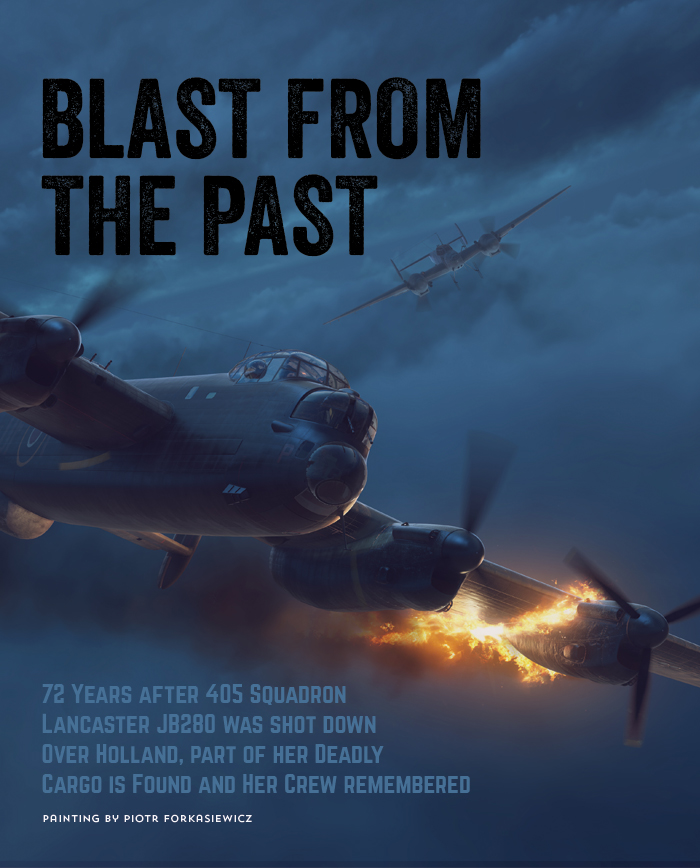 |
|
|
All day long on the first of January 1944, the
weather at RAF Gransden Lodge and throughout most of Cambridgeshire was
grey and cloudy with typical English mists drifting across the airfield.
The winds were moderate and out of the west. The Lancaster bomber crews
of No. 405 Pathfinder Squadron stationed at Gransden Lodge were stood
down for the day, some recouping from New Year’s Eve revelry. At a
briefing they learned that there would be an operation that night, but
take-offs wouldn’t begin until after midnight. The target was Berlin.
They had several hours to endure the stress of inactivity, but once they
had strapped in, they would settle down. They were Pathfinders after
all, elite bomber crews, the best of the best, who would lead the Bomber
Stream to the target and mark it by accurate bombing, the kind of
accuracy the Pathfinders were trained for and capable of. Flying Officer Tom Donnelly and his crew were ready for the task. Donnelly himself was a veteran on his second tour of operations. Surviving one tour was an accomplishment, beating odds that were well stacked against making it home alive. His bomb aimer, Sergeant William L.T. Clark, was feeling good. He had spent the previous evening in the company of his brother Jack who was also in the RCAF, reminiscing about life back in Vancouver and getting home after the war. He was happy to be in Donnelly’s crew—the skipper was experienced and fun to be around. He wore the ribbon of the Distinguished Flying Medal on his battle dress jacket and the winged “O” pin of an airman who had completed a full tour already. It gave Clark a sense of confidence seeing that ribbon, but looking at that pin, he had to wonder when Donnelly’s luck would run out. Luck was such a huge part of it. The 405 Pathfinder Squadron operations and
planning room at RAF Gransden Lodge, about 16 kilometres west of
Cambridge, England. In this busy and smoke-filled room, missions were
planned down to the smallest detail, taking into account all variables
such as fuel, daily signals, meteorology, intelligence, German defences
and bomb fusing times. After planning, the squadron assembled for a
briefing before being driven to their aircraft. Photo: RCAF
Always, when the target was Berlin, the boys got
quiet and moody. Stress was hard to hide. Berlin was a 1,900 kilometre
round trip in the proximity of hundreds of other bombers in total
darkness, across flak concentrations and the deadly hunting grounds of
Luftwaffe night fighters. It was reasonable for man to be worried.
At around midnight the signal flare went up and
the twelve Lancasters of 405 Squadron RCAF moved out to the runway in
the dark. Donnelly and his boys were in Lancaster LQ-K, RAF serial
number JB280. The Lancaster had survived three and a half months of
operations with 405 since its delivery date on the 16th of September
1943, a week after it rolled out of the factory. In her belly, LQ-K
carried a relatively light load, for they were flying a long way
tonight—four 1,000 lb. bombs and one 4,000 lb. bomb called a “cookie.”
This type of ordnance was designed for the destruction of industrial
centres. At 23 minutes past midnight, in the very early hours of the
second day of 1944, Donnelly, Bomb Aimer William Clark, Navigator Jerry
Salaba, Flight Engineer Leslie Miller, Radio Operator Brian West, and
Air Gunners Ron Zimmer and Ron Watts lifted off the active runway in
darkness and radio silence, climbing and circling until the squadron was
formed and headed to join the Bomber Stream where a total of 421
Lancasters coming from all over southern England would join together in
the dark of night and head toward Berlin—1,684 Merlin engines delivering
the whirlwind of vengeance, almost 3,000 young men huddled in darkness,
cold and menace, surrounded by fear, powered by courage and love of
their brothers. Though there were thousands of men up there in the night
sky, each man felt alone—dry mouth, high pitched voice, darting eyes,
forced jocularity. Somewhere near the coast of England they joined
the stream and headed across the North Sea. With them was a small group
of fifteen Bomber Command Mosquitos that would attempt a diversionary
attack on Hamburg. It didn’t work. The night fighters’ dispatchers were
not fooled this night. As Donnelly and his crew settled down over the
North Sea for the long flight across Holland and Germany, night fighters
were rising to meet the stream. These highly experienced Luftwaffe crews
flying night fighting variants of the Junkers Ju 88 and Messerschmitt Bf
110 were the true scourge of Bomber Command. Unlike searchlights and
flak, which to some extent could be avoided, night fighters were unseen,
vicious and above all, unpredictable. The entire crew relied on the
sharp eyes and night vision of their two air gunners—Watts in the rear
turret and Zimmer in the top turret. Watts was 33 years old, young by
today’s standards, but ancient in a squadron of teenage boys and twenty
somethings. Zimmer had just turned 20 years olf. As they crossed the coast of Holland, they
avoided the heaviest concentrations of flak and droned on through the
night towards their destiny—alone among 420 other crews. Around 2 AM,
Salaba would have called Donnelly on the intercom to let him know the
Dutch-German border was just ahead. In a few minutes they would be over
the homeland of the enemy. Here they would face the most determined of
defences. About the same time as Salaba updated his
skipper, Luftwaffe ground radars were vectoring a Messerschmitt Bf 110
night fighter into the Bomber Stream close to LQ-K. It was pitch dark at
20,000 feet, but a trained night fighter pilot could spot the exhaust
flames and sullen dark shapes against a murky black sky. The pilot of
the all-black Messerschmitt was Leutnant Friedrich Potthast, known as
“Fritz” to his pals. With him in the cockpit were two others, a rear
gunner and a radio operator in contact with the ground. Potthast had
been a fighter pilot since near the beginning of the war, but he had
only three other kills to show for all that fighting, two Blenheims on
19 August 1941 in particular. But tonight, he would begin a streak that
would net him 8 more night kills before his death five months later.
Night fighting was proving to be his forte. |
|
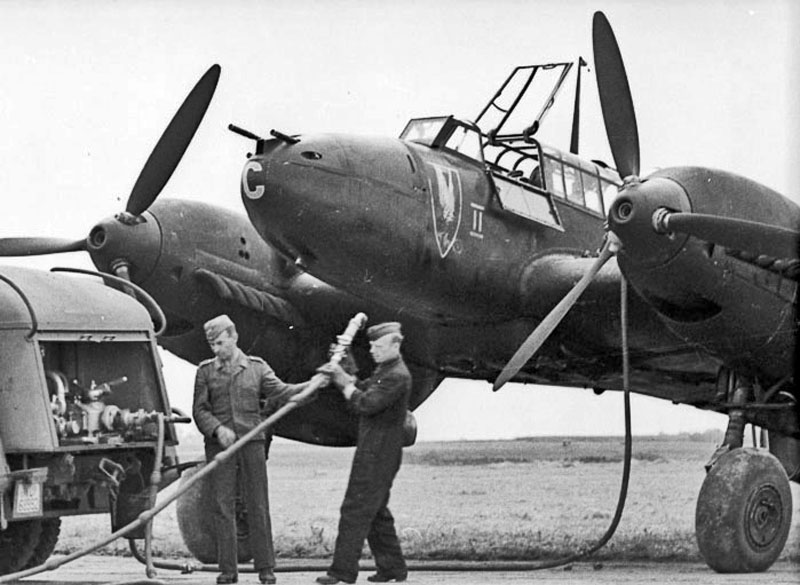 |
Luftwaffe ground crew refuel a Messerschmitt Bf
110 night fighter of the famous Nachtjagdgeschwader 1. Of all the night
fighter squadrons in the Luftwaffe, NJG-1 was the most successful,
shooting down an astonishing 2,311 enemy aircraft. The unit paid a heavy
price for this reputation with 676 aircrew killed in action. The high
number of victories by NJG-1 was testimony to the terrible dangers faced
by Bomber Command aircrews every night. The unit’s emblem was a diving
white falcon with a red lightning bolt striking a map of Great Britain.
The pilot of the night fighter that shot down JB280 was Leutnant
Friedrich “Fritz” Potthast, an ace with 11 kills to his name (8 at night
and 3 by day) when he was shot down nearly five months later on the
night of 21–22 May 1944 near Sourbrodt in eastern Belgium. Lancaster
JB280 was his fourth kill. Night fighter Bf 110s had a crew of
three—pilot, rear gunner and radio (radar) operator. It is not known who
was with him the night he shot down the Donnelly crew, but on the May
night he died, his two crew members were Feldwebel (Sergeant) Albert
Kunz and Obergefreiter (Aircraftman) Hans Lautenbacher.
Photo via Bundesarchiv |
|
We will never know the full details of what
happened over the next ten minutes in the night sky near the
Dutch-German border, but at approximately 2:10 AM, the remains of
Lancaster JB280 and its crew came shrieking, flaming and tumbling out of
the night sky near the small town of Nieuw-Schoonebeek, slamming into
the ground not 200 metres from the German border. The wreckage contained
the bomb load of Donnelly’s JB280, but likely centrifugal forces had
sent the five bombs off on their own trajectories [photos of the
fuselage section on the ground do not show the kind of damage one would
expect if the bombs exploded while still attached.]
One can imagine the spectacular and life-changing drama of a
four-engine bomber falling in flames from the night sky—the
shrieking wind, the rending of metal, the ultimate devastating
impact with the ground. Today, such a powerful scene would be world
news, but on the night of 1–2 January, it happened 28 times along
the flight path of the Bomber Stream in and out of Berlin. The 28
Lancasters held 196 young men. Night after night, month after month,
year after year, metal and youth would be broken against the
obdurate ground of Europe. While it became commonplace in a broad
sense, it was nonetheless a traumatic event for local witnesses,
causing in many cases injury and death, and in all cases powerful
emotions and haunting memories for the rest of their lives.
|
|
 |
Dutch citizens come by to look at the wrecked
fuselage of Lancaster JB280 lying in a farm field near the town of
Nieuw-Schoonebeek. The framework at the right of the fuselage is the
floor above the bomb bay with doors gone. The faring around the hole in
the centre of the fuselage section is for the H2S Radar, the antenna
housing having been destroyed. These wrecks would soon be loaded on to
trucks and driven away to be melted down for German production. Photo
via drentheindeoorlog.nl |
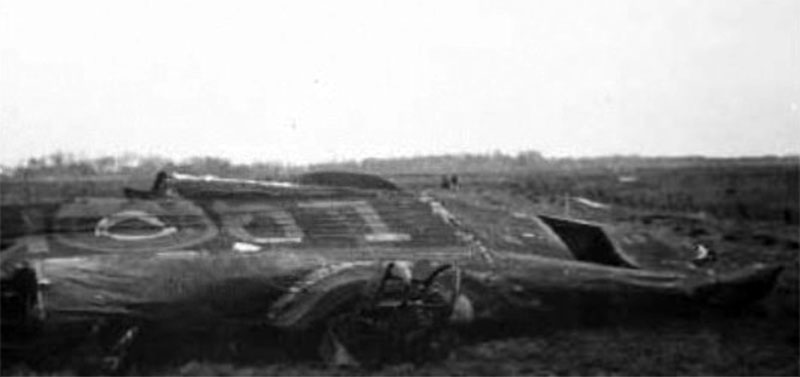 |
The same Lancaster JB280 fuselage section as
above, but viewed from the other (top) side. We can clearly make out the
letters LQ-K. The Fraser-Nash power-operated dorsal turret glazing
framework lies crushed at centre. Photo via drentheindeoorlog.nl |
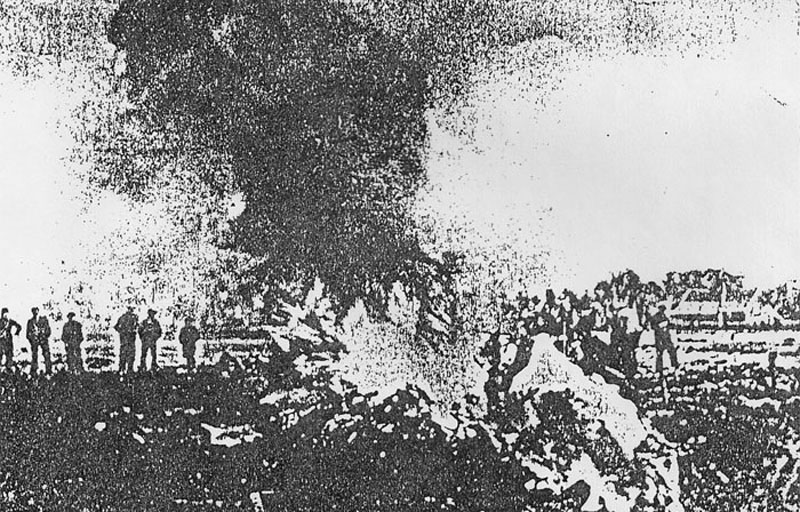 |
A photocopy of a
photograph taken the morning after the crash. Clearly, there was nothing
to do but watch the fire burn itself out. Image via Rob Wethly |
|
As the wreckage of JB280 and her seven young
crew members lay burning and smoking on Lambers’ farm, the Bomber
Stream, heard but unseen in the night sky, continued it relentless and
harrowing journey into the heart of Germany. Donnelly’s demise was
possibly witnessed by others in the stream—tracers in the distance,
flames blowtorching in an invisible hurricane, silent screams—but none
could know who it was. Gunners and pilots of other Lancasters could only
glance at the drama and perhaps inform their crews (There goes
another—bloody hell!) but they had a job to do. If anything, the arcing
smear of flame in the distant night sky that was once a Lancaster was a
warning that wolves were in their midst. Men turned away from the death
and concentrated on watching their own immediate sky. Terrible… but
lucky us. Of the night’s work by Bomber Command, the RCAF
post war journal called The RCAF Overseas had this to say of the night:
“January 1st, 1944, marked the opening of the second year of operations
of the R.C.A.F. Bomber Group, a component of Bomber Command. The twelve
months had seen a notable development in the operational efficiency of
the squadrons so that with the opening days of the New Year, members of
the Group could look forward in quiet confidence to a period of
increasing responsibility. In the year to come, the Group, its growing
pains past and forgotten, was to come into its own as one of the most
efficient fighting units in all the United Nations Air Forces. Our Lancasters, almost without exception, found
complete cloud cover from base to target and back when they attacked
Berlin on New Year’s night [actually they took off after midnight—on
January 2nd]. For the most part they stooged along between cloud layers
and as a result were little bothered by searchlights except when the
clouds cleared momentarily to allow the Cologne-Kassel-Frankfurt band to
break through. Night fighters were not particularly in evidence and flak
was never troublesome, yet the raid was far from being an outstanding
success. The target area was completely covered, the tops
of the clouds varying from 10 to 18,000, and many of our kites found a
further heavy layer above that. Furthermore, the pathfinders were having
an off night and their work was erratic and scattered. As a result, the
host of bombers, averaging 12 per minute over the target, returned to
their various bases with little concrete knowledge as to whether the
hundreds of tons dropped had really achieved the desired result, but
quite convinced in their own minds that the raid, considered as
saturation bombing, had been largely abortive. Nevertheless, such a
weight of bombs dropped on a city like Berlin must have done very
considerable damage and the effort therefore was not entirely in vain.
F/O T.H. Donnelly, D.F.M., on his second tour of operations, was lost on
this raid with his crew, F/O A.J. Salaba, FS W.L.J. Clarke and Sgts.
B.S.J. West, R.E. Watts, R. Zimmer and L.G.R. Miller.” |
|
|
As the sun came up over Nieuw-Schoonebeek, on
that terrible Sunday morning, there was no thought of going to church…
at least not yet. In the thin light of winter, townsfolk set to the grim
and fruitless task of searching for survivors and policing up the broken
youth of the Royal Canadian Air Force. According to the official report
filed by local military police chief Hendrik Rinsma, three of the bodies
were found intact, two others were in pieces scattered about and God
knows how the other two were found. It was clear from the craters, or
perhaps detonations, that four bombs had exploded. They had no way of
knowing how many bombs the aircraft had been carrying. They were buried three days later in the
Schoonebeek General Cemetery where they remain today. Some time later
after their identities were known, white crosses were erected with their
names, ranks and service numbers painted on them. As tragic and
traumatic as the destruction of JB280 and her crew was, it was not much
more than a brief side note in the litany of death and suffering that
was the Second World War, one of 28 such events to happen on that night
alone in that sector. It warranted but three typewritten lines in the
405 Squadron Operational Record Book for January 1944. It was imperative
that Wing Commander Reg Lane and his 405 Squadron move forward and put
the horrors they witnessed every night behind them. There would be time
to weep after victory. While Canadians have let the seventy-two years of intervening time fade the memories of all of our lost youth of the Second World War, the Dutch have most definitely not. Perhaps it is gratitude. Perhaps it is the fact of the flaming Lancasters full of courage that came to dash themselves upon their soil. Perhaps it is the memory of their terrible suffering at the hands of the Nazis and the rushing elation of liberation that drives them to remember. I’ve said it many times before and I will say it again, the Dutch are better at remembering Canada’s fallen than Canadians. While we should be grateful, we should also be ashamed. |
|
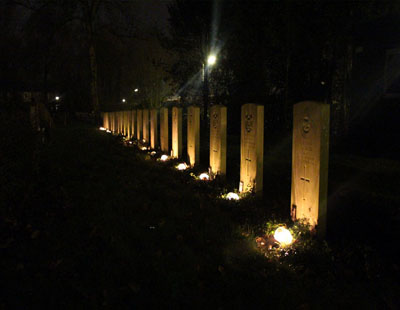
The story of JB280 and the Donnelly crew did not end with their burial.
Throughout the seven decades since that terrible, but all-too-common,
event in the opening hours of 1944, the townspeople of Oud-Schoonebeek
have tended the graves and paid homage to the seven fallen men of JB280
as well as several other young men whose lives came to an end along with
their aircraft near Schoonebeek. Like many village cemeteries throughout
Europe, the original white crosses have been replaced by the now
tragically ubiquitous granite tablet headstones of the Commonwealth War
Graves Commission. Like many such beautiful places throughout Europe,
the headstones of Donnelly’s crew have been meticulously tended and
loved by the people of Nieuw-Schoonebeek. Here, on Christmas Eve, 2015,
the members of Study Group Air War Drenthe (SLO Drenthe), a society
dedicated to the preservation of the stories of men like those aboard
JB280 and their brethren, light votive lights at each of the fallen’s
headstone. Photo via Rob Wethly |
|
|
72 years later — JB280 delivers her
final payload |
|
|
There is much more to see on the following
web link. Photographs of crew, graves, finds in the fields etc Blast from the Past |
|
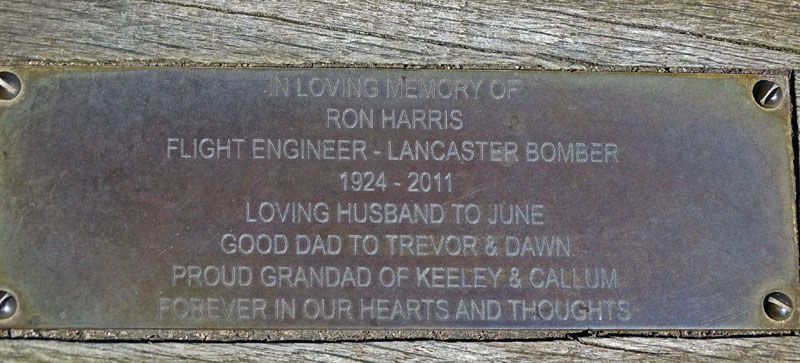 Memorial in Royal Sutton Coldfield Park |
|
Other sites of interest
http://www.lincsaviation.co.uk/history/history-of-the-lancaster.htm/a>
hhttp://www.challoner.com/aviation/pix/65-6.html
http://www.kiwiaircraftimages.com/lanc.html>
http://www.military.cz/british/air/war/bomber/lancaster/lancaster_en.htm
http://en.wikipedia.org/wiki/Avro_Lancaster
http://www.lancasterfm159.freeservers.com/
http://www.britannica.com/normandy/articles/Lancaster.html
http://www.nicks-cave.pwp.blueyonder.co.uk/jane/lancs1b.htm
and of course, the modellers delight:
http://www.turbosquid.com/FullPreview/Index.cfm/ID/145989/intType/7/stgCHSource/Popular
http://www.canadianflight.org/giftshop/h-033.htm
http://web.inetba.com/aircraftmodelscorp/item7372.ctlg
http://www.aikensairplanes.com/corgi/c32608.htm
http://www.asrmcs-club.com/ - Air Sea Rescue